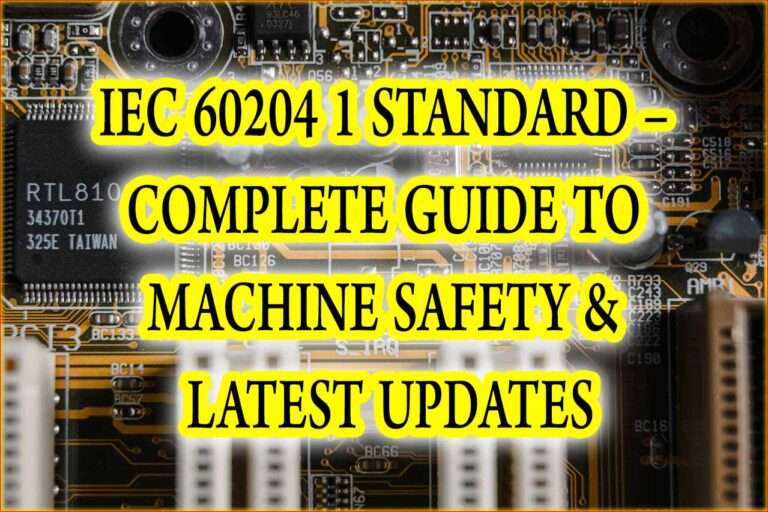ISO 13849 and IEC 61508 – Functional Safety Standards Explained for Engineers
Understanding iso 13849 and iec 61508 is essential for anyone involved in machine safety, industrial automation, and functional safety design. Both standards aim to reduce risks and prevent accidents, but they apply to different industries and follow different approaches. When engineers compare iso 13849 and iec 61508, they often find similarities in structure, yet the depth of analysis and the required design methods vary. This article explores their purpose, their differences, and where each standard fits best. Every concept is explained in short, clear sentences to maintain excellent readability.

Table of Contents
Functional safety has become a major priority in global manufacturing. Modern equipment uses high-speed motors, sensors, controllers, and automation systems that can fail in unpredictable ways. When safety systems fail, people get hurt. So organisations rely on safety standards to guide design decisions and reduce hazards. Among these standards, iso 13849 and iec 61508 are the most influential. They form the backbone of machine safety and programmable electronic safety systems. Understanding how they work helps engineers select the right standard for any application. Find out more about iec 61439 busbar clearance
Understanding iso 13849 and iec 61508 for machine safety
ISO 13849 focuses on machinery safety. It guides designers on how to build safe control systems for machines such as conveyors, packaging machines, robotic cells, CNC machines, presses, and material-handling equipment. The standard introduces Performance Levels (PL) that measure the reliability of the safety function. Each safety function must achieve a required PL based on the severity of possible injury, the frequency of exposure, and the possibility of avoiding harm.
IEC 61508 is broader. It applies to all electrical, electronic, and programmable electronic systems. It covers industries like oil and gas, power generation, chemical plants, automation, and transportation. This standard uses Safety Integrity Levels (SIL) instead of performance levels. SIL levels range from SIL 1 to SIL 4 depending on the required failure probability and the risk associated with the application. IEC 61508 goes deeper into design methods, lifecycle processes, hardware architecture, diagnostic coverage, and software development techniques. Explore details on iec 61508 functional safety
When comparing iso 13849 and iec 61508, the main difference lies in their scope. ISO 13849 is machine-specific and practical. IEC 61508 is system-wide and theoretical. Yet both aim to achieve functional safety, reduce risk, and improve the reliability of safety-related systems.
Core differences between iso 13849 and iec 61508
Both standards introduce structured methods to achieve safe design. However, they use different terminologies, design approaches, and verification requirements. ISO 13849 is used in machinery where mechanical and simple electro-mechanical devices play a major role. It explains how to calculate reliability using mean time to dangerous failure, diagnostic coverage, and architecture categories. Engineers use practical approaches such as Category B, 1, 2, 3, and 4. Category 4 offers the highest reliability with complete redundancy and continuous monitoring. Explore details on iec standard for underground cable laying
IEC 61508 involves more advanced systems. It handles microcontrollers, safety PLCs, sensors, actuators, logic solvers, and programmable systems. It introduces hardware safety integrity, systematic capability, software development processes, failure rate analysis, and reliability modelling. It is more detailed because it covers every stage of the safety lifecycle. Dive deeper into complete guide to iec 61508
To help you understand these differences quickly, the following table summarises the main comparison between iso 13849 and iec 61508.
Comparison Table: iso 13849 and iec 61508
| Feature | ISO 13849 | IEC 61508 |
|---|---|---|
| Industry focus | Machinery | All industries with electrical and electronic safety systems |
| Safety metric | Performance Level (PL) | Safety Integrity Level (SIL) |
| Risk assessment | Simple, machinery-focused | Detailed, system-wide |
| Complexity | Moderate | High |
| Hardware architecture | Category-based | Quantitative SIL modelling |
| Software requirements | Limited | Extensive, lifecycle-based |
| Typical use cases | Machine controls, presses, packaging, robotics | Oil and gas, process control, power, automation |
This table shows that iso 13849 and iec 61508 serve different environments. Machine builders prefer ISO 13849 because it is simple, direct, and easy to implement. Large industrial systems rely on IEC 61508 because they require deeper analysis and more robust reliability modelling.
Why engineers compare iso 13849 and iec 61508
Engineers often work in mixed environments where machinery interacts with programmable safety controllers. For example, a robotic cell may use machine safety functions following ISO 13849 while also integrating safety PLCs that comply with IEC 61508. Understanding iso 13849 and iec 61508 ensures consistency across all safety components. It helps engineers align performance levels and safety integrity levels. It also avoids over-design or under-design, which can increase costs or reduce safety. Know more about iec 61508
Many safety experts use ISO 13849 when a machine contains simple logic devices such as contactors, limit switches, or relays. When the design includes advanced programmable devices such as safety PLCs, safety relays with diagnostics, or intelligent sensors, the integration often leans toward IEC 61508. This is because programmable electronics require a higher level of analysis to ensure safe operation.
The overlap between iso 13849 and iec 61508 becomes clear when dealing with hybrid systems. Manufacturers using safety PLCs certified under IEC 61508 can still achieve machine performance levels defined in ISO 13849. This compatibility allows flexible design options and reinforces safety alignment across multiple devices. Get complete information about iec standard for busbar sizing
Relationship between iso 13849 and iec 61508 in safety lifecycle
Every safety standard follows a lifecycle approach. The lifecycle defines how safety requirements are determined, implemented, verified, and maintained. ISO 13849 focuses on practical lifecycle steps such as risk assessment, design validation, verification, and documentation. The lifecycle is simpler because machinery safety systems often have limited complexity.
IEC 61508 includes a full safety lifecycle that spans concept, design, implementation, validation, installation, operation, maintenance, and retirement. It requires documentation for each phase. This ensures every part of the system meets the required SIL. Uncover insights on iec standard for lighting lux level
Although they differ in complexity, both standards share the same goal. They ensure that safety functions reduce risks to an acceptable level. They guide engineers through the entire process, ensuring dangerous failures are minimized through structured methods. This link between iso 13849 and iec 61508 ensures that all safety systems follow best practices, even when used in different industries.
Real-world examples using iso 13849 and iec 61508 together
A packaging machine often uses ISO 13849 because it contains guards, emergency stops, contactors, and simple sensors. The machine’s main safety functions, such as stopping a motor when a guard opens, are evaluated through performance levels. The designer calculates PL values using B10d data, diagnostic coverage, architecture category, and common cause failure factors.
However, if the same machine uses a safety PLC to coordinate multiple safety zones, the safety PLC may be IEC 61508 certified. This means the programmable logic must meet SIL reliability levels. The machine designer integrates the PLC functions while still ensuring the overall machine safety meets ISO 13849.
This combination demonstrates how iso 13849 and iec 61508 complement each other in real environments. Machine builders often combine both standards without conflict. Read in detail about iec 61439 busbar calculation
Mapping PL and SIL when using iso 13849 and iec 61508
One common question engineers ask is how to compare PL and SIL levels. While not identical, several studies provide approximate mapping. The table below shows a simplified comparison.
Comparison Table: PL vs SIL
| ISO 13849 PL | Approximate IEC 61508 SIL |
|---|---|
| PL a | Below SIL 1 |
| PL b | SIL 1 (low boundary) |
| PL c | SIL 1 |
| PL d | SIL 2 |
| PL e | SIL 3 |
This mapping helps engineers align safety functions when mixing components. However, it is important to remember that PL and SIL calculations use different methodologies. PL focuses on category, diagnostic coverage, and reliability of components. SIL focuses on probability of dangerous failure per hour (PFHD), hardware metrics, systematic capability, and lifecycle.
Benefits of understanding iso 13849 and iec 61508
Understanding iso 13849 and iec 61508 gives engineers more flexibility in design. It also ensures that every safety function is aligned with the correct standard. Companies benefit by improving safety performance, reducing accidents, and lowering downtime. Following the right standard also helps with certification, legal compliance, and global acceptance. Dive deeper into instrument earthing iec standard
Both standards promote risk reduction. This helps machine builders and industrial designers develop safer equipment. It protects workers and reduces the likelihood of operational failures. The ability to compare and apply iso 13849 and iec 61508 increases confidence during design and ensures systems remain safe throughout their lifecycle.
Conclusion on iso 13849 and iec 61508
ISO 13849 and IEC 61508 play a critical role in functional safety engineering. Both standards reduce risk and guide the development of reliable safety systems. ISO 13849 focuses on machinery and uses performance levels. IEC 61508 applies to all industries and uses safety integrity levels. When engineers understand both, they can design safety systems that are consistent, reliable, and compliant. Understand better about nec 430.32
In a world where automation grows every day, safety becomes essential. Learning how iso 13849 and iec 61508 work gives engineers a competitive advantage. It ensures they build machines and systems that protect workers, reduce failures, and meet global safety expectations.
Follow Us on Social:
Subscribe our Newsletter on Electrical Insights to get the latest updates in Electrical Engineering.
#iso13849, #iec61508, #functionalSafety, #safetyStandards, #machineSafety, #SILCertification, #PLSafety, #riskAssessment, #industrialAutomation, #safetyCompliance, #safetylifecycle, #safetyintegritylevel, #ENISO13849, #IECStandards, #engineeringSafety





